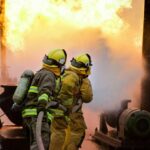With the extreme weather that the nation has been experiencing over the last couple of months. we thought it would be a good time to review what’s in your disaster preparedness kit and what your emergency procedures are at work and at home. April 21st – 25th also happens to be Severe Weather Awareness Week in Minnesota and each day focuses on a different topic to help educate how to be prepared should severe weather strike.
Monday – Review what alerts and warnings mean in your city. Know the difference between a watch and a warning and when you should seek shelter. Learn how and why sirens are activated. You can also research to see if you can subscribe to receive personal weather alerts on your cell phone or other communication device. Your state’s Department of Public Safety should have more information for you.
Tuesday – Review thunderstorms, lightning, hail, or any other storms that are typical to your area. Any kind of storm can result in damage and the 3 mentioned are no strangers to that. Thunderstorms can produce straight-line wind gusts that can reach up to 100 mph. Lightning can be present with or without rain and can even be present without thunder (but that’s usually because the storm is too far away for thunder to be heard). Hail causes nearly $1 Billion in damage every year and large hail can even fall at a rate of 100 mph.
Wednesday – Review what is included in your emergency preparedness kit. Replace anything that is expired or too old to be effective. Make sure you have plenty of water for everyone, non-perishable food including a can opener if appropriate, a radio, a flashlight and extra batteries, a first-aid kit with disinfectant, pain reducers, and bandages of all sizes, a local map, tools to turn off utilities if needed, garbage bags and plastic ties, and a whistle to signal for help. You may also consider the following based on the needs of your family: prescription medications and glasses, infant formula and diapers, pet food if you have pets, important family documents, extra cash and change, sleeping bags, blankets, and pillows, a fire extinguisher, activity books, games, and puzzles, plastic utensils and cups, and paper towels and plates.
Thursday – Review floods and tornadoes. Your local government will likely have an emergency plan for flooding, so it would be a good idea to know what it is and review it with your family. If tornadoes affect your area, know what the siren sounds like and practice whenever you city does a drill. If you have children, practice with them so they will know what to do just in case you’re not home. Your local Department of Public Safety will likely have different scenarios on what to do in your particular situation (i.e.: no basement, apartment, car, mobile home, etc.)
Friday – Review what to do in extreme heat. Heat disorders occur when the body loses its ability to cool itself down through circulation and sweating, which causes the body’s core temp. to rise. To prevent heat related disorders, drink lots of cool, not cold, fluids that do not contain alcohol or large amounts of sugar. To cool off, take a cool shower or bath or move to an air-conditioned space. Fans may provide comfort, but when temps reach the high 90s, fans will not prevent heat disorders. Never leave anyone in a closed, parked car, including pets. Leaving the windows even slightly open does not significantly decrease the heating rate of the car, even on a breezy day.
Even if it seems like an elephant to review everything all at once, taking one piece at a time will help you and your family feel safe and prepared if something should happen.



